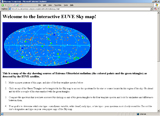Guest Investigator Puzzle
After a brief introduction to astronomy, stellar types and the Guest Investigator program for the Extreme Ultraviolet Explorer (EUVE) NASA satellite, students conduct a brief astrophysics lab. This lab consists of matching the EUVE spectra of various kinds of "mystery" stars with the spectra of known stars taken at Extreme Ultraviolet (EUV) and optical wavelengths to determine their type.
Key Questions
1. What is the purpose of a GI proposal?
2. How can astronomers recognize different stars using stellar spectra data?
Learning Objectives
1. Students will be able to recognize four types of stars using stellar spectra data.
2. Students will know how researcher astronomers obtain spectra from stars using a NASA satellite through the Guest Investigator (GI) process.
General Subject Areas
Astronomy, Space Science, Physics
|
 Author: Tim Keyes, Isabel Hawkins
Author: Tim Keyes, Isabel Hawkins
VIEW THE LESSON
Student Activities
Students will compare and contrast the four types of stars using data retrieved from the EUVE satellite. Students will act as true astronomers and create a GI proposal before using real NASA data.
Student Prerequisites
Students will need to understand the basic properties of light. Completion of The Light Tour and How Satellites See lessons is recommended.
Assessment
For individual student grades, the authors suggest grading the student's Guest Investigator proposal. For group grades, the authors suggest grading the group's skymap star-type determinations for a group grade. An alternative to this would be to include these assignments in a portfolio with a brief critique for each assignment.
Extended Learning
Available on lesson plan pages- students are encouraged to explore other stars in the universe and identify their type using stellar spectra data.
|
View Teacher Feedback
Send Us Your Feedback
Time Requirements
Approximately 2 hours prep time for the teacher and 3-5 hours class time.
Materials Required
-Photos of satellites, planets and stars
-One packet of handouts for each student (masters for handouts are included in the lesson)
-One computer for each group of four students
Required Plugins
N/A
Additional Resources
Lesson Plan
Best For Grades
middle school
National Science Education Standards (NSES)
grades 5-8
grades 9-12
State Science Standards
Grade 5 Earth Sciences
Grade 8 Physical Science
Have a science question? Visit our Ask an Expert page. Email questions or comments about SEGway resources to: outreach@ssl.berkeley.edu
|












